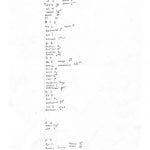Sarah Heavren ’21: The Shelton Shorthand Project

Hi! My name is Sarah Heavren and I have been working on the Shelton Shorthand Project. I have been working with Dr. Weimer from the history department transcribing any shorthand in Thomas Shepard, Jr.’s writings. It has been a fun challenge deciphering the 17th century writings and making a list of the symbols to see which ones match the Shelton shorthand system and which ones Shepard, Jr. created himself.
Above is a small sample of what shorthand written using the Shelton shorthand system looks like. The Shelton system was one of a few commonly used during the seventeenth century, the time during which Thomas Shepard, Jr. lived and wrote his many sermons. Thomas Shepard, Jr. was the son of Thomas Shepard, who was a well-known preacher in the Massachusetts Bay colony. Like his father, Shepard, Jr. became a preacher and would frequently slip into shorthand in the diaries in which he wrote his sermons. Although the Massachusetts Historical Society and the American Antiquarian Society both have extensive collections of Shepard, Jr.’s writings, no one has ever really studied them. Because large parts of them are written in shorthand, no one has previously figured out what actually lies deep within the pages of Shepard, Jr.’s longhand writing.
My encounter with Thomas Shepard, Jr. and the Shelton shorthand system dates back to last December when I joined Dr. Adrian Weimer’s research. During the school year, I work as a research assistant in the history department, meaning that I help professors with their various personal research projects. Dr. Weimer had done the difficult work of figuring out which shorthand system Shepard, Jr. used, and it would be my job to learn the system as well as learn any of Shepard, Jr.’s nuances. I was very excited to embark on a journey that would allow me to pull from the tool set I have developed from both my history and my math majors. Trying to decipher the shorthand involves paying attention to patterns and a having a problem-solving mindset, two qualities that I have been developing in my abstract algebra class. Over winter break and throughout the spring semester, I worked to teach myself the shorthand system while also developing a glossary-like list of frequent symbol combinations, common words, or deviations from the system that Shepard, Jr. used.
The most exciting part of the research is that I am one of the few people in the past few centuries to understand what Shepard, Jr. wrote so long ago. His words have been cryptically preserved in various symbols, waiting for someone to put his puzzle together. There are still some symbols that are yet to be deciphered, and the occasional sloppy handwriting or ink blob can pose challenges. However, I have found much satisfaction in the seemingly tedious work. Some people like crossword puzzles, others prefer Sudoku; I prefer deciphering symbols from the Shelton shorthand system.






